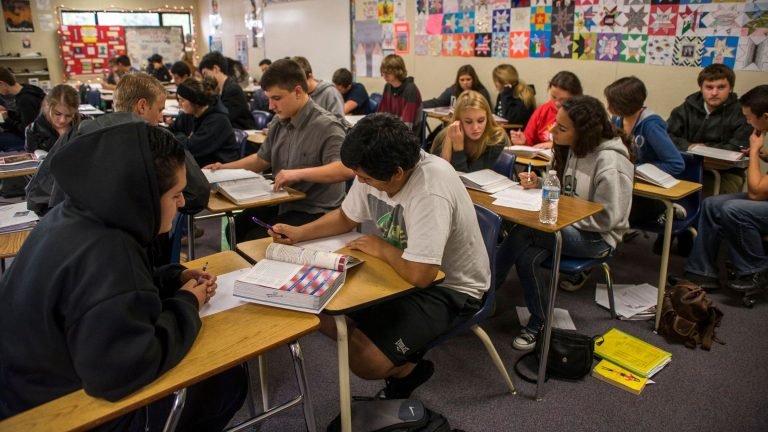The jigsaw classrooms strategy can turn competitive classrooms with a lot of students struggling into cooperative classrooms improving their grades and social skills.
The findings (Jigsaw Classrooms)
Educators confronted a social dilemma in the early 1970s, following the civil rights movement, that had no obvious answer. Well-intentioned efforts to desegregate America’s public schools were causing severe issues across the country.
Children from ethnic minorities, the majority of whom had previously attended chronically underfunded schools, now found themselves in classrooms dominated by more privileged White students. As a result, pupils from affluent homes frequently shone brightly, while those from impoverished families frequently struggled.
Of course, this trying circumstance seemed to support long-held stereotypes: that Blacks and Latinos are unintelligent or lazy, while Whites are forceful and competitive. As a result, tensions between children of different ethnic groups have grown, as have differences in academic achievement between Whites and minorities.
Elliot Aronson and colleagues discovered
One of the key causes of this problem was the competitive nature of the usual classroom, based on traditional psychology studies on how to alleviate tensions between competing groups (e.g., see Allport, 1954; Sherif, 1958; see also Pettigrew, 1998) Students work on tasks alone in a regular classroom, and teachers frequently call on students to see who can publicly exhibit his or her expertise.
Read More:- How Do Child Development And Education Awards Correlate To Each Other?
Anyone who has ever been called to the board of directors to solve a long division problem and then became confused about dividends and divisors knows how damaging public failure can be. When children’s friends fail, they typically make nasty remarks that do little to help the issue.
But what if kids were taught how to collaborate in the classroom as part of a cohesive team? Is it possible for a cooperative learning environment to help struggling students? The answer appears to be a resounding yes when done correctly.
Aronson and colleagues in Austin
In 1971, Aronson and colleagues in Austin, Texas, devised and executed the jigsaw classroom technique in response to real-world educational problems. If the children in a jigsaw classroom were working on a World War II project, for example, a class of 30 children might divide into five different groups of six children each.
Within each group, a different youngster would be assigned the task of investigating and learning about a different topic: Khanh may study Hitler’s rise to power, Tracy might study the United States’ entry into the war, Mauricio might study the construction of the atomic bomb, and so on.
Students from various groups with the same task would be asked to compare notes and share information to ensure that each group member had a thorough understanding of the content. The students would then be divided into their primary groups, with each student presenting his or her “piece of the jigsaw” to the other members of the group.
Teachers, of course, play a vital role in keeping students engaged and resolving any difficulties that may arise. Let’s say Mauricio was having trouble presenting his information about the atomic bomb.
If Tracy made fun of him, the teacher would soon tell her that; while making fun of her teammate may make her feel good. She is harming herself and her group because everyone will expect to know everything there; to know about the atomic bomb on the upcoming quiz.
Significance
When used appropriately, the jigsaw classroom strategy can transform competitive classes with many struggling kids into cooperative classrooms. With formerly difficult children showing tremendous academic and social improvements.
You May Also Like:- How Student Attendance Can Improve Institutional Outcomes?
In jigsaw classrooms, children learn to build cross-ethnic connections and eliminate ethnic and cultural preconceptions, resulting in increased student liking. Finally, jigsaw classrooms appear to reduce absenteeism while also increasing children’s empathy. By altering the way children learn, the jigsaw technique has the potential to radically improve education in a multi-cultural society.
Application in Real Life
The jigsaw classroom use in hundreds of classrooms around the country. Since its presentation in the 1970s, ranging from elementary schools; where it was first designed to high school and college courses.
Researchers know the procedure is effective since it has thoroughly research utilizing sound research methods. For example, in many circumstances, students in various classrooms are studying the same material. Randomly randomized to receive regular education (no intervention) or jigsaw instruction.
Academic performance has increased, preconceptions and prejudice have decreased, and social interactions have improved in studies conducted in real classrooms.
Benefits of cooperative learning methods
Aronson isn’t the only one who has looked into the benefits of cooperative learning methods. Robert Slavin, Elizabeth Cohen, and others began to document the value of different forms of cooperative learning programs shortly; after Aronson and colleagues began to describe the power of the jigsaw classroom.
As of this writing, around 1500 schools across the country had implemented some form of systematic cooperative learning. The concept appeared to be gaining traction. Perhaps the only real concern about cooperative learning strategies; like the jigsaw classroom is why they have not adopted much more widely.
To Read More Visit: The Coinance


